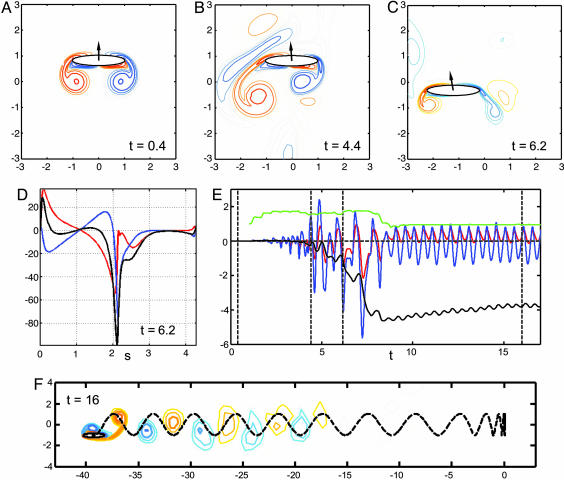Fig. 1.
The body and fluid dynamics (shown as a contour plot of the vorticity field) during the stages of takeoff for a flapping body in a sample case. The body aspect ratio is 5:1, body density is 32 times fluid density, and Refr = 35. For the first upstroke (0 < t < 0.5), a positive horizontal velocity perturbation is prescribed, increasing to 0.2% of the peak vertical velocity; subsequently the horizontal velocity is set by horizontal fluid forces. (A) Startup motion and flow are nearly vertically symmetric, so horizontal forces on the body are small. (B) Nearly four periods after the body is freed, the flow has become very asymmetric, while the body velocity is still nearly vertical because of body inertia. (C) The body collides with a previously shed vortex at t = 6.2, which decreases suction at the right edge by creating a vortex dipole. (D) The horizontal component of the pressure (blue) and viscous (red) stresses acting on the surface of the body, at the instant shown in C. The black line is the sum of the stresses. The arc length around the body surface (moving counterclockwise) is denoted by s, with the right edge at s = 0 and left edge at s = 2.14. The peak near s = 0 has a much smaller magnitude than the trough at s = 2.14, coincident with the formation of a vortex dipole at s = 0. (E) The horizontal pressure (blue line) and viscous (red line) forces acting on the body as a function of time. Dashed lines mark the instants of B, C, and F. Also shown is horizontal velocity of the body, ub(t) (black line), which shows quasi-steady locomotion for t ≳ 8. The green line shows the negative (for separation from other graphs) of cycle-averaged input power P(t), defined as  .(F) The subsequent vortex street and center-of-mass trajectory (dotted line) in the quasi-steady state of unidirectional (leftward) flight. Shed vortices form a staggered array with net fluid momentum directed away from the body.
.(F) The subsequent vortex street and center-of-mass trajectory (dotted line) in the quasi-steady state of unidirectional (leftward) flight. Shed vortices form a staggered array with net fluid momentum directed away from the body.

